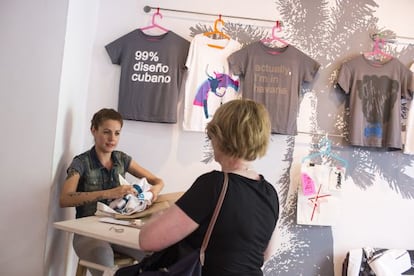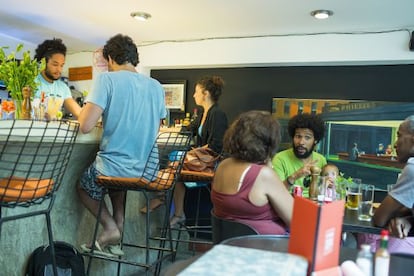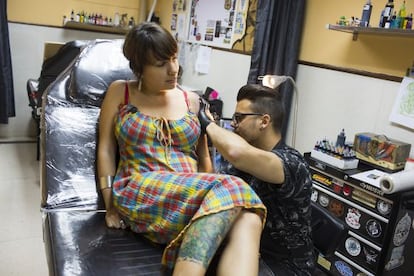The new Cuba is in Old Havana
Signs of Ra¨²l Castro¡¯s reforms are beginning to show in the city¡¯s historic center More private firms are opening, with the state counting on them to boost restoration work

Old Havana is the new Havana. And it only took six months to happen. Dozens of new private businesses have been opening their doors in the city¡¯s historic center, a well-looked-after urban space that stretches over two kilometers in which 55,000 people live and more than 200 buildings of significant cultural value have been renovated in recent years. Among the new establishments to have cropped up on this privileged spot through which 90 percent of visitors to the island pass are tattoo parlors such as La Marca, charming bars featuring jazz bands playing on the staircase, graphic design stores such as Clandestina, whose owner Idania del R¨ªo only used to see a promising tomorrow in ¡°leaving Cuba.¡± ¡°Today, for the first time, I feel that I have a future in my country,¡± she says.
Today, for the first time, I feel that I have a future in my country¡± Idania del R¨ªo, owner of the Clandestina design store
Thirty-three-year-old Idania studied at the Havana Higher Design Institute and after several fruitless years and attempts to ¡°start something of my own,¡± last year took advantage of?reforms implemented by the Ra¨²l Castro administration allowing for private property purchases to acquire a half-demolished building on Villegas Street. Then she and her Spanish business partner, Leire Fern¨¢ndez, spent months renovating it before opening on February 11. The store has ¡°an alternative vibe¡± and irreverent collections of items such as pillow cases embossed with phrases like ¡°remedy for insomnia,¡± made from fabrics featuring images of passports and 100-CUC bills ¨C the Cuban convertible peso, the local currency used for exchanging foreign money that is equivalent to the US dollar ¨C a nod to the things that keep Cubans awake at night.
Elsewhere in the store, ¡°Vamos a la zafra¡± (Let¡¯s go to the harvest) is a collection of children¡¯s toys crafted from little Russian-style cars made of recycled plastic. T-shirts with Clandestina¡¯s logo and a series of hemp bags with hip designs and the logo ¡°99% Cuban design¡± have enjoyed notable success. ¡°Things move slowly in Cuba,¡± the owners say. ¡°It can take two months for them to authorize the placement of a poster on the door, but you can feel the changes.¡±

¡°This is a really exciting moment,¡± Idania adds. ¡°There are people coming back who left Cuba years ago. Some, like me, feel that they can try their luck here, that there is now an opportunity to move forward.¡±
There are 11 million people in Cuba and 5.2 million active workers ¨C almost 100 percent of whom worked for the state until recently. After the Special Period crisis of the late 80s and 90s, and the economic reforms to alleviate its impact, the state declared that over one million government posts were now redundant and opened the door to private enterprise. Today there are 470,000 cuentapropistas, or non-government workers, on the island. The state has also allowed the buying and selling of homes and the formation of different kinds of business cooperatives in sectors such as construction and textiles.
Perhaps these changes are felt most intensely in Havana¡¯s majestic Plaza Vieja, which dates back to the late 16th century. The old square is now the symbol of the new push in private business and how it could help improve the city. Just a year ago, every business in Plaza Vieja belonged to the state.

First, Caf¨¦ Bohemio opened. Then, a massage parlor set up shop next door. Last November, a couple opened Az¨²car, a modern bar-restaurant with spectacular views over the square. Just a few days later another entrepreneur and his Russian friend opened a locale next door also affording views over the square. Customers can see children sitting in class at the public school across the way.
In December, La Vitrola, a restaurant that specializes in Creole cuisine, opened on the corner of Muralla and San Ignacio streets. The house special of ropa vieja, black beans, salad, beer, dessert and coffee costs less than €10?¨C still prohibitively priced for the vast majority of Cubans but affordable for a growing sector of the population. The establishment features retro Coca-Cola refrigerators and advertisements from the 1950s. Once inside, you feel transported to another era.
¡°I never thought I would see Plaza Vieja so alive,¡± says Juan Agust¨ªn Plasencia, who has worked in the old state-owned restaurant business and is now the manager at La Vitrola where a marvelous American jukebox pumps out tunes by Arsenio Rodr¨ªguez, Benny Mor¨¦ and Celia Cruz. Plasencia says this ¡°paladar¡±?¨C the local name for these new private restaurants?¨C like the other new businesses in the area, have had the support of the city¡¯s historical office, the government bureau responsible for the renovations going on in Old Havana, and its director Eusebio Leal. ¡°He has visited us on several occasions to encourage us to contribute to the renovation work and to become leading figures in the area¡¯s restoration.¡±
Eusebio Leal¡¯s work is well-known. Besides his support for entrepreneurial projects, his management and initiatives have helped save the historic center¡¯s valuable architectural heritage. Back in the 1980s, the city was falling apart. The pace of restoration was five buildings a year. ¡°Thirty percent of the territory has been renovated in the last two decades and we have restored more than 200 buildings of high cultural value,¡± says Patricia Rodr¨ªguez, who is in charge of coordinating the plan for Old Havana¡¯s restoration.
Right now the historical office is restoring the Capitol, which was the seat of the Congress and the Senate during the Republican era. By the end of the year, it will once again house the national parliament. Quite a symbol of the new times. Much has been done in 20 years. ¡°But we cannot wait another 20 years to see results,¡± Rodr¨ªguez says. Where before the state took responsibility for restoration, now it encourages private businesses to bring their own efforts to the task and supports them ¨C a notable change in mentality.

¡°At this moment there is a boom in private initiatives in the area, and it is a good thing,¡± Rodr¨ªguez says, adding that the office should make sure it is ¡°leading the restoration process in the private sector well.¡±
Rodr¨ªguez cites the case of hairdresser Gilberto Valladares, known to all as ¡°Papito.¡± In a short while, Papito turned his salon into a veritable community cultural project in which dozens of people on Aguiar street participate. ¡°The office has fixed up the street and handed over locales and public spaces where there are now bars, stores, art galleries, a beauty school, and other community projects?¨C all of it private,¡± Papito explains. ¡°It¡¯s not just about economic profits; it¡¯s about creating wealth through culture and seeing that come back to benefit the neighbors.¡±
In 2007, sick of bureaucratic roadblocks, Valladares left for Mexico. He came back in 2009. ¡°And until now¡¡±, he says, before an associate calls him away. A group of government workers is waiting for him. They have come to provide advice on how to be more efficient in this kind of communal workplace ¨C something completely unthinkable just two years ago.
Translation: Dyane Jean Fran?ois
The challenge of inequality
Ra¨²l Castro¡¯s loosening of economic restrictions obviously widened disparities in a country whose central pillar was egalitarianism for nearly half a century. In today¡¯s Cuba there are people with lots of money, but they are in the minority. Some restaurant owners, independent farmers, artists, and professionals in emerging sectors are able to spend €200 on a dinner, but the average salary remains around $20 a month. The truth is that more than 90 percent of Cubans are living on the national currency and suffering for it.
If a €10 meal in La Vitrola is a third of a doctor¡¯s salary, Cuba faces a clear challenge: what policies does it have to implement in order to protect the most disadvantaged and redistribute wealth?
Eusebio Leal knows the answer. You can take a walk with him in Old Havana and visit the old Bel¨¦n convent, now a center for the elderly that provides free services to 800 people. It is one of many social programs in the area financed in part with taxes collected from these new entrepreneurs.
To those who criticize them at home for going too fast and those who criticize them abroad for going too slow, he only has one thing to say: ¡°Let them talk if they want to, I am a child of my times.¡±
Tu suscripci¨®n se est¨¢ usando en otro dispositivo
?Quieres a?adir otro usuario a tu suscripci¨®n?
Si contin¨²as leyendo en este dispositivo, no se podr¨¢ leer en el otro.
FlechaTu suscripci¨®n se est¨¢ usando en otro dispositivo y solo puedes acceder a EL PA?S desde un dispositivo a la vez.
Si quieres compartir tu cuenta, cambia tu suscripci¨®n a la modalidad Premium, as¨ª podr¨¢s a?adir otro usuario. Cada uno acceder¨¢ con su propia cuenta de email, lo que os permitir¨¢ personalizar vuestra experiencia en EL PA?S.
?Tienes una suscripci¨®n de empresa? Accede aqu¨ª para contratar m¨¢s cuentas.
En el caso de no saber qui¨¦n est¨¢ usando tu cuenta, te recomendamos cambiar tu contrase?a aqu¨ª.
Si decides continuar compartiendo tu cuenta, este mensaje se mostrar¨¢ en tu dispositivo y en el de la otra persona que est¨¢ usando tu cuenta de forma indefinida, afectando a tu experiencia de lectura. Puedes consultar aqu¨ª los t¨¦rminos y condiciones de la suscripci¨®n digital.








































